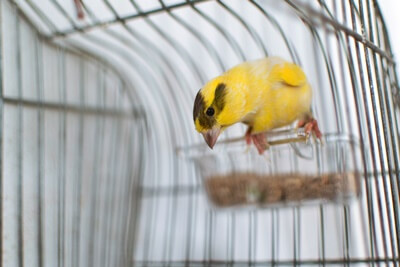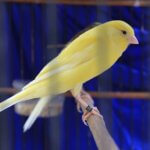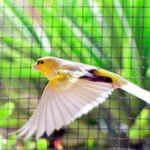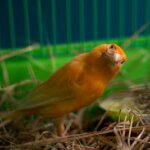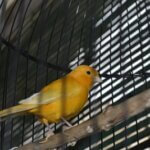Canaries shouldn’t live in small, enclosed spaces, preferring as much freedom as possible. The canary will benefit from more enrichment, exercise, and exploration if you can get a large cage.
As natural hoppers, canaries revel in large, wide cages that allow them to move freely from end to end at their leisure. Big cages also enable you to place more perches, watering bowls, and toys inside. These will make your bird’s life more exciting, happier, and healthier.
However, a canary isn’t being mistreated if you buy a smaller cage. As long as you meet the minimum size requirements, it’ll enjoy its space, especially if you let it out to fly in a bird-safe room.
What Is The Best Size Cage for a Canary?
The ideal cage size for a canary is 3 feet (or more) on all sides.
This ensures the canary can fly around easily, which promotes exercise. Equally importantly, this space will minimize accidents where the canary crashes into the bars or decorations while flying.
Of course, finding such a cage in your local pet store may be difficult, but a cage that’s about 18-30 inches wide and more than 24 inches high will suffice. This bird cage size is easier to find.
You may be tempted to get the widest cage possible at the expense of height. However, all cages should be high enough for the canary to fly up and down between different tiers. If the cage is too short, your canary will feel boxed in and trapped.
Wild canaries have 360 degrees of completely free movement. According to Scientific American, canaries fly through various levels of a tree and from one perch to the next between trees.
Recommended Cage for A Canary
Although size is the key consideration when selecting a canary cage, there are other factors you should consider before making the final choice, including:
Shape
Cages with corners, whether square or rectangular, are a better choice than round ones because canaries like to move from corner to corner and hide in corners when resting or afraid.
A round-shaped cage denies them safety spots, leaving them unsettled, exposed, and vulnerable.
Bars
While most cages have closely-arranged bars, some models are designed for larger birds, especially if they’re sizable. So, the cages may have their bars spaced too wide for a canary’s safety.
The spaces between canary cage bars shouldn’t exceed half an inch. Otherwise, the canary might attempt to escape. Even if it fails, it may get a leg stuck between the bars and injure itself.
Ease of Cleaning
To optimize the cleaning process, get a cage that’s easy to open, disassemble, and reach inside.
Opt for a cage with a detachable or retractable base. During daily spot cleans and weekly deep cleans, you can empty and sanitize the cage without stressing the canary.
For deep cleaning, detachable bases and broad doors will make it easier to reach inside to clean the bars, retrieve decorations, and sanitize the area. At the same time, your canary is safe in a temporary or travel cage.
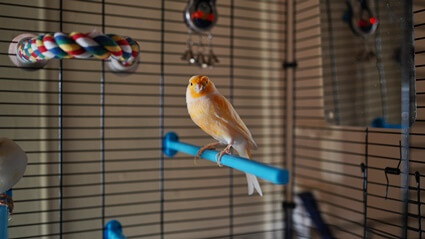
What To Put In A Canary Cage
Even if your canary has a large cage, it’ll grow bored and depressed if there are no enrichment items inside. It needs toys and additions to entertain and meet its basic needs, including:
Perches
The cage should mimic the canary’s natural environment, so providing several perches of varying sizes, shapes, and textures are essential.
You can opt for rope perches, wood perches, and pedi-perches. The latter is designed to wear down canaries’ nails through use, just like trees and abrasive surfaces in the wild.
Meanwhile, wood perches are ideal for canaries that like to sharpen their beaks through pecking, and rope perches provide climbing opportunities.
Hanging perches at different levels throughout the cage allow canaries to jump from one perch to the next as they would when exploring a tree.
Food Bowl
A single food bowl is enough if you only have one canary.
However, if you’re hosting multiple birds inside a single cage, you should add extra bowls. This ensures they won’t fight over the meals and reduces the chance of food running out too soon.
Since canaries prefer elevated positions, placing food bowls above the cage’s floor is recommended. You can also space them out at various heights because this provides enrichment as your canary jumps or flutters from one to another while making it feel safer.
Eating is a vulnerable endeavor, and sitting on the floor puts wild canaries in danger of predators. An elevated bowl removes this problem, but you must position the bowls in an easily reachable position.
Water Bowls
Canaries need water for drinking, cleaning, and playing when bored. So, include 2-3 water bowls in the cage; some will be used exclusively for drinking, while others may be used for bathing.
Multiple sources ensure the water doesn’t run out too soon or grow contaminated.
To encourage your canaries to use the bowls properly, provide a suspended water bottle for drinking water, and a water bowl for bathing and recreation.
Where Should A Canary Cage Be Placed?
Placing a cage in the center of the room will make a canary feel exposed and threatened.
Since canaries are fearful birds, you should position their cages next to a wall. This will ensure they don’t need to watch for danger in all directions and can trust that their back is safe when angled against the wall.
Never position the cage near a window or door, as canaries can become fearful if they can see other animals outside. Also, they’ll be exposed to drafts and falling temperatures.
Keep the cage in a room with minimal temperature variations and away from the kitchen. Rapid temperature changes, cooking fumes, and smoke can harm your canary’s respiratory system.
Avoid keeping your canary on or near the floor since they’ll instinctively assume predators are hunting at ground level. They only feel safe high up, where they have a vantage point, it’s more difficult for predators to reach, and they can easily fly to safety.
Instead, use a stand to elevate the cage so your canary can observe its surroundings.

